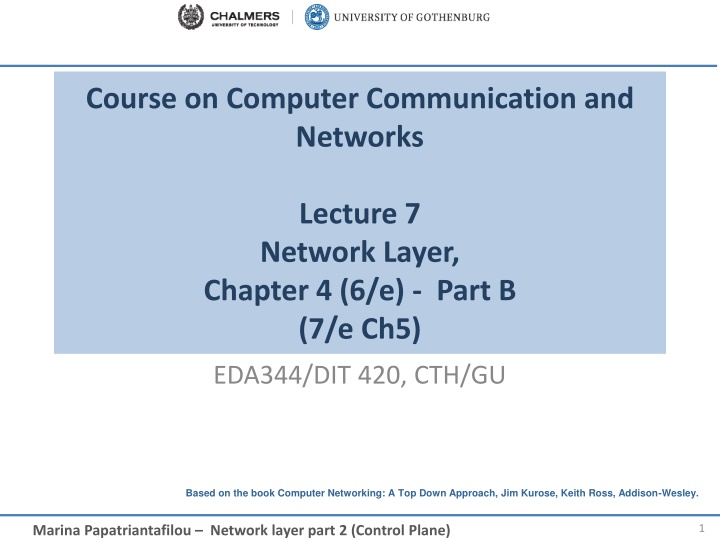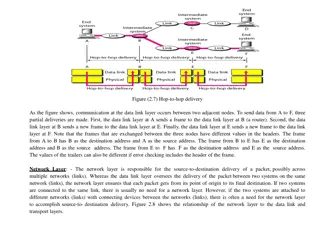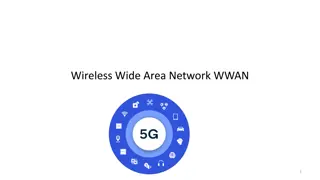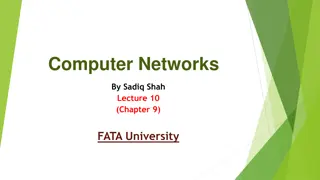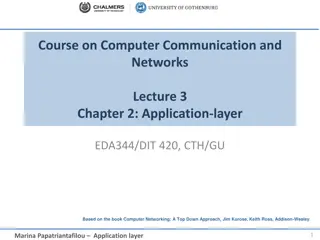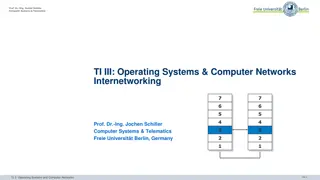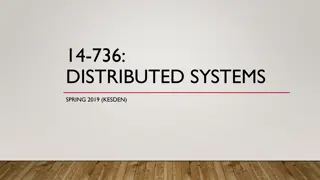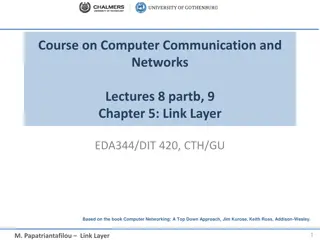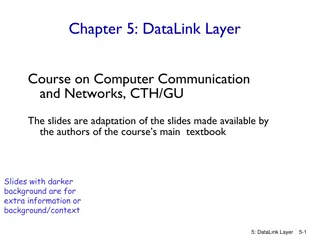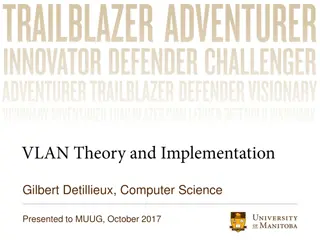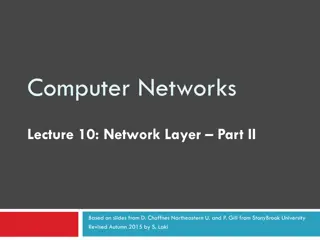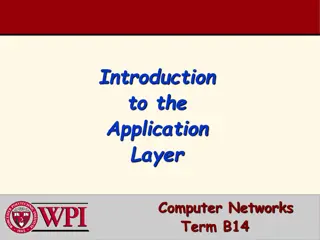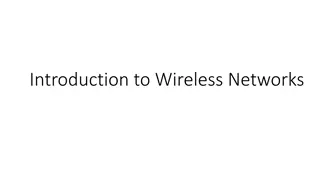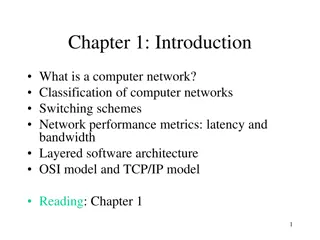Computer Communication and Networks: Network Layer Overview
The Network Layer in computer communication involves transporting segments from senders to receivers, encapsulating and delivering data, examining header fields in datagrams, and managing routing and forwarding. Explore the interplay between routing and forwarding, service models, architecture, and IP addressing in the Internet. Dive into control, path selection, routing algorithms, and protocols like RIP, OSPF, and BGP.
Download Presentation

Please find below an Image/Link to download the presentation.
The content on the website is provided AS IS for your information and personal use only. It may not be sold, licensed, or shared on other websites without obtaining consent from the author.If you encounter any issues during the download, it is possible that the publisher has removed the file from their server.
You are allowed to download the files provided on this website for personal or commercial use, subject to the condition that they are used lawfully. All files are the property of their respective owners.
The content on the website is provided AS IS for your information and personal use only. It may not be sold, licensed, or shared on other websites without obtaining consent from the author.
E N D
Presentation Transcript
Course on Computer Communication and Networks Lecture 7 Network Layer, Chapter 4 (6/e) - Part B (7/e Ch5) EDA344/DIT 420, CTH/GU Based on the book Computer Networking: A Top Down Approach, Jim Kurose, Keith Ross, Addison-Wesley. 1 Marina Papatriantafilou Network layer part 2 (Control Plane)
Network layer application transport network data link physical Consider transporting a segment from sender to receiver sending side: encapsulates segments into datagrams receiving side: delivers segments to transport layer network data link physical network data link physical network data link physical network data link physical network data link physical network data link physical network data link physical network data link physical application transport network data link physical network data link physical network layer protocols in every host, router examines header fields in all datagrams passing through it network data link physical network data link physical 2 Marina Papatriantafilou Network layer part 2 (Control Plane)
NW layers job - routing and forwarding Interplay between the two: routing algorithm determines path through network (control-plane functionality) routing algorithm local forwarding table header value output link a b c d a b c d a b c d forwarding table determines local forwarding at this router (data-plane functionality) 1 2 3 value in arriving packet s header 1 0111 2 3 3 Marina Papatriantafilou Network layer part 2 (Control Plane)
Roadmap Network Layer PREVIOUS Lect. Forwarding versus routing Network layer service models Network layer architecture (shift): Software-Defined Networks Inside a router The Internet Network layer: IP, Addressing & related: IPv4, maskig&forwarding, obtaining an IP address, DHCP, NAT, IPv6 Now: Control, routing path selection/routing algorithms Link state Distance Vector Hierarchical routing instantiation, implementation in the Internet routing protocols RIP OSPF BGP ICMP (control protocol) 4 Marina Papatriantafilou Network layer part 2 (Control Plane)
Graph abstraction: costs 5 3 v w 5 2 u z 2 1 Graph: G = (N,E) 3 1 2 x y N = set of Nodes routers = { u, v, w, x, y, z } 1 E = set of Edges links = { (u,v), (u,x), (u,w), (v,x), (v,w), (x,w), (x,y), (w,y), (w,z), (y,z) } Cost of link x w is c(x,w) = 3 Cost of link could be always 1 hop, or related directly to delay or inversely to bandwidth, or any other metric Question: What is the least-cost path between u and z? Cost of path (x1, x2, x3, , xp) = c(x1,x2) + c(x2,x3) + + c(xp-1,xp) Routing algorithm: finds least-cost path 5 Marina Papatriantafilou Network layer part 2 (Control Plane)
Routing Algorithm Classification Global or decentralized? Static or dynamic routing? Global: all routers have complete and global knowledge about topology, and all link-costs Static: routes change slowly over time, manually configured Dynamic: routes change more quickly periodic update, or in response to link-cost changes Decentralized: router knows physically- connected neighbors, link costs to neighbors exchange of info with neighbors Iteratively calculate the least-cost paths to other routers Network Layer 4-6 Marina Papatriantafilou Network layer part 2 (Control Plane)
Roadmap Network Layer Forwarding versus routing Network layer service models Network layer architecture (shift): Software-Defined Networks Inside a router The Internet Network layer: IP, Addressing & related Control, routing path selection/routing algorithms Link state Distance Vector Hierarchical routing instantiation, implementation in the Internet routing protocols RIP OSPF BGP ICMP (control protocol) 7 Marina Papatriantafilou Network layer part 2 (Control Plane)
A Link-State (LS) Routing Algorithm Dijkstra s shortest path algo link costs known to all nodes Each node floods link state multicasts with costs to its neighbors etc all nodes get same info Each node computes least cost paths from itself to all other nodes gives forwarding table for that node iterative: after k iterations, knows least cost path to k destinations 4-8 Marina Papatriantafilou Network layer part 2 (Control Plane)
Dijsktras Algorithm at node u c(x,y): link cost from x to y. Initially cost(x,y) = if not direct neighbors D(v): Distance; current value of cost of path from source to destination v p(v): predecessor node, i.e. previous node that is neighbor of v along current path from the source to node v N': set of Nodes whose least cost path definitively known 1 Initialization: 2 N' = {u} 3 for all nodes v 4 if v adjacent (directly attached neighbor) to u 5 then D(v) = c(u,v) 6 else D(v) = 7 8 Loop 9 find node w not in N' such that D(w) is a minimum 10 add node w to N' 11 update D(v) for all v adjacent to w and not in N' : 12 D(v) = min{ D(v), D(w) + c(w,v) } 13 /* new cost to v is either old cost to v or known 14 shortest path cost to w plus cost from w to v */ 15 until all nodes N in N' 9 Marina Papatriantafilou Network layer part 2 (Control Plane)
Dijkstras algorithm: example node u v w x y z D(v),p(v) 2,u 2,u D(x),p(x) 1,u D(w),p(w) 5,u 4,x 4,x 3,y D(y),p(y) 2,x 2,x Step N' u ux uxv uxvy uxvyw uxvywz D(z),p(z) 4,y 4,y 0 1 2 3 4 5 5 3 v w 5 2 u z 2 1 3 1 2 x y 1 10 Marina Papatriantafilou Network layer part 2 (Control Plane)
Dijkstras algorithm: forwarding table Resulting shortest-path tree from node u as root: v w u Root z x y Resulting forwarding table in u: destination cost via link (u,v) (u,x) 2 v x y w z 1 (u,x) (u,x) (u,x) 2 3 4 Networ Layer 4-11 Marina Papatriantafilou Network layer part 2 (Control Plane)
Dijkstras algorithm, discussion Algorithm complexity: n nodes each iteration: need to check all nodes, not in N n(n+1)/2 comparisons: Order of (n2) Oscillations possible: e.g., if link cost = delay-based or traffic-based, dynamically variable metric must avoid these metrics But: Good for small networks Link-cost changes are not frequent, more stable network Faster to converge when changes in link-costs 12 Marina Papatriantafilou Network layer part 2 (Control Plane)
Roadmap Network Layer Forwarding versus routing Network layer service models Network layer architecture (shift): Software-Defined Networks Inside a router The Internet Network layer: IP, Addressing & related Control, routing path selection/routing algorithms Link state Distance Vector Hierarchical routing instantiation, implementation in the Internet routing protocols RIP OSPF BGP ICMP (control protocol) 13 Marina Papatriantafilou Network layer part 2 (Control Plane)
Distance Vector (DV) Algorithm Bellman-Ford Equation: Define dx(y) := cost of least-cost path from x to y If v is any neighbor to x with link cost c(x,v) and has dv(y) as least-cost path to y Then the DV estimate: dx(y) = min { c(x,v) + dv(y) } cost from neighbor v to destination y cost to neighbor v min taken over all neighbors v of x 4-14 Marina Papatriantafilou Network layer part 2 (Control Plane)
Distance vector (DV) algorithm each node: iterative, asynchronous: each local iteration caused by: local link cost change DV update message from neighbor distributed: each node notifies neighbors only when its DV changes neighbors then notify their neighbors if necessary wait for (change in local link cost or msg from neighbor) recompute estimates if DV to any dest has changed, notify neighbors 15 Marina Papatriantafilou Network layer part 2 (Control Plane)
Bellman-Ford: example Nodes v, x & w are the neighbors of u 5 dv(z) = 5, dx(z) = 3, dw(z) = 3 3 v w 5 2 BF equation says: u z 2 1 3 du(z) = min { c(u,v) + dv(z), c(u,x) + dx(z), c(u,w) + dw(z) } = min {2 + 5, 1 + 3, 5 + 3} = 4 1 2 x y 1 Node x that achieves minimum is the next hop in least-cost path to z forwarding table 16 Marina Papatriantafilou Network layer part 2 (Control Plane)
Dx(z) = min{c(x,y) + Dy(z), c(x,z) + Dz(z)} = min{2+1 , 7+0} = 3 Dx(y) = min{c(x,y) + Dy(y), c(x,z) + Dz(y)} = min{2+0 , 7+1} = 2 node x table cost to cost to x y z 0 2 7 x y z 0 2 0 1 7 1 0 x y z x y z 2 3 from from node y table cost to y x y z 2 1 x y z 2 0 1 z x 7 from node z table cost to x y z x y z from 7 1 0 time 17 Marina Papatriantafilou Network layer part 2 (Control Plane)
Dx(z) = min{c(x,y) + Dy(z), c(x,z) + Dz(z)} = min{2+1 , 7+0} = 3 Dx(y) = min{c(x,y) + Dy(y), c(x,z) + Dz(y)} = min{2+0 , 7+1} = 2 node x table cost to cost to cost to x y z 0 2 7 x y z 0 2 3 2 0 1 7 1 0 x y z 0 2 3 2 0 1 3 1 0 x y z x y z x y z from from from node y table cost to cost to cost to y x y z x y z 0 2 7 2 0 1 7 1 0 x y z 0 2 3 2 0 1 3 1 0 2 1 x y z x y z z x y z 2 0 1 x from 7 from from node z table cost to cost to cost to x y z 0 2 7 2 0 1 3 1 0 x y z 0 2 3 2 0 1 x y z x y z x y z x y z from from from 7 1 0 3 1 0 time 18 Marina Papatriantafilou Network layer part 2 (Control Plane)
DV: link cost changes (good news) Link cost changes: decreased cost node detects local link cost change updates routing info, recalculates distance vector if DV changes, notify neighbors 1 y 4 1 x z 50 At time t0, y detects the link-cost change, updates its DV, and informs its neighbors. At time t1, z receives the update from y and updates its table. It computes a new least cost to x and sends its neighbors its DV. good news travels fast At time t2, y receives z s update and checks its distance table. y s least costs do not change and hence y does not send any update to z. 19 Marina Papatriantafilou Network layer part 2 (Control Plane)
DV: link cost changes (bad news) Link cost changes: increased cost bad news travels slow - count to infinity problem! 44 iterations before algorithm stabilizes! y already knows z has cost 5 to reach x y therefore announces cost 6 to reach x z announces cost is now 7, etc.. Poisoned reverse: If z routes through y to get to x: z tells y its (z s) distance to x is infinite (so y won t route to x via z) 60 y 4 1 x z 50 bad news travels slow 4-20 Marina Papatriantafilou Network layer part 2 (Control Plane)
Comparison of LS and DV algorithms Message complexity LS: with n nodes, E links, O(nE) messages sent DV: exchange between neighbors only, until convergence Robustness: what happens if router malfunctions? LS: each node computes only its own table limited damage DV: node can advertise incorrect path cost each node s table used by others error propagates through network Convergence due to changes LS: may have oscillations fast convergence DV: may be routing loops count-to-infinity problem slow convergence 4-21 Marina Papatriantafilou Network layer part 2 (Control Plane)
Roadmap Network Layer Forwarding versus routing Network layer service models Network layer architecture (shift): Software-Defined Networks Inside a router The Internet Network layer: IP, Addressing & related Control, routing path selection/routing algorithms Link state Distance Vector Hierarchical routing instantiation, implementation in the Internet routing protocols RIP OSPF BGP ICMP (control protocol) 22 Marina Papatriantafilou Network layer part 2 (Control Plane)
Hierarchical Routing Our routing study thus far - idealization all routers identical network flat not true in practice scale: millions of destinations! can t store all destinations in routing tables! LS routing info exchange would swamp links! DV would never terminate administrative autonomy Internet = network of networks each network administrator may want to control routing in its own network 23 Marina Papatriantafilou Network layer part 2 (Control Plane)
aggregate routers into regions, autonomous systems (AS) Internet: > 39,000 AS Interconnected ASs 3c 3a 2c 3b 2a AS3 2b 1c AS1 AS2 1a 1b 1d border router at edge of its own AS Forwarding table configured by both intra- and inter-AS routing algorithms Intra-AS Routing algorithm Inter-AS Routing algorithm Forwarding table intra-AS sets entries for internal destinations inter-AS sets entries for external destinations 24 Marina Papatriantafilou Network layer part 2 (Control Plane)
Roadmap Network Layer Forwarding versus routing Network layer service models Network layer architecture (shift): Software-Defined Networks Inside a router The Internet Network layer: IP, Addressing & related Control, routing path selection/routing algorithms Link state Distance Vector Hierarchical routing instantiation, implementation in the Internet routing protocols RIP OSPF BGP ICMP (control protocol) 25 Marina Papatriantafilou Network layer part 2 (Control Plane)
Intra-AS Routing also known as Interior Gateway Protocols (IGP) most common Intra-AS routing protocols: RIP: Routing Information Protocol [DV] OSPF: Open Shortest Path First [LS] EIGRP: Enhanced Interior Gateway Routing Protocol (Cisco proprietary) Network Layer 4-26 Marina Papatriantafilou Network layer part 2 (Control Plane)
RIP ( Routing Information Protocol) distance vector algorithm included in BSD-UNIX Distribution 4.3 in 1982 distance metric: number of hops (max = 15 hops) Version 1 classful and version 2 classless From router A to subnets: destination hops u 0 v 1 w 1 x 2 y 2 z 1 u v w A B x C D z y 27 Marina Papatriantafilou Network layer part 2 (Control Plane)
RIP Table processing RIP routing tables managed by application-level process called routed (route daemon) advertisements periodically sent in UDP packets (port 520) using broadcast (or multicast, RIP v.2) routed routed transport (UDP) transport (UDP) network forwarding (IP) table network forwarding table (IP) link link physical physical 28 Marina Papatriantafilou Network layer part 2 (Control Plane)
Roadmap Network Layer Forwarding versus routing Network layer service models Network layer architecture (shift): Software-Defined Networks Inside a router The Internet Network layer: IP, Addressing & related Control, routing path selection/routing algorithms Link state Distance Vector Hierarchical routing instantiation, implementation in the Internet routing protocols RIP OSPF BGP ICMP (control protocol) 29 Marina Papatriantafilou Network layer part 2 (Control Plane)
OSPF (Open Shortest Path First) open : just means publicly available (RFC 2328) uses Link State algorithm complete topology map built at each node route computation using Dijkstra s algorithm works in larger networks (hierarchical structure with areas) OSPF advertisements sent within area via flooding. carried in OSPF messages directly over IP with protocol number 89 (no UDP- or TCP-transport) sent at least every 30 minutes 30 Marina Papatriantafilou Network layer part 2 (Control Plane)
OSPF features security: all OSPF messages can be authenticated (to prevent malicious intrusion) multiple same-cost paths allowed Send HELLO messages to establish adjacencies with neighbors to check operational links hierarchical OSPF in large domains. 4-31 Marina Papatriantafilou Network layer part 2 (Control Plane)
Hierarchical OSPF boundary router backbone router backbone area border routers Area 3 internal routers Area 1 Area 2 4-32 Marina Papatriantafilou Network layer part 2 (Control Plane)
Roadmap Network Layer Forwarding versus routing Network layer service models Network layer architecture (shift): Software-Defined Networks Inside a router The Internet Network layer: IP, Addressing & related Control, routing path selection/routing algorithms Link state Distance Vector Hierarchical routing instantiation, implementation in the Internet routing protocols RIP OSPF BGP ICMP (control protocol) 33 Marina Papatriantafilou Network layer part 2 (Control Plane)
Internet inter-AS routing: BGP BGP (Border Gateway Protocol) the de facto standard routing protocol on the Internet Complex protocol Communicates over TCP port 179 with authentication BGP provides each AS a means to: o Obtain prefix reachability information from neighboring ASs. o Propagate reachability information to all AS-internal routers. o Determine good routes to prefixes based on reachability information and policy. 34 Marina Papatriantafilou Network layer part 2 (Control Plane)
BGP basics pairs of routers (BGP peers) exchange routing info over semi- permanent TCP connections: BGP sessions BGP sessions need not correspond to physical links. advertising paths to different destination network prefixes ( path vector protocol) when AS3 advertises a prefix to AS1: AS3 promises it will forward datagrams towards that prefix. AS3 can aggregate prefixes in its advertisement 3c BGP message 3a 3b 2c AS3 other networks 1c 2a 2b other networks 1a 1b AS2 1d AS1 35 Marina Papatriantafilou Network layer part 2 (Control Plane)
Distributing Reachability Info With external BGP eBGP session between 3a and 1c, AS3 sends prefix reachability info to AS1. 1c can then use internal BGP iBGP to distribute new prefix info to all routers in AS1 1b can then re-advertise new reachability info to AS2 over 1b-to-2a eBGP session when router learns of new prefix, it creates entry for prefix in its forwarding table. eBGP session 3c iBGP session eBGP message 3a 3b 2c AS3 other networks 1c 2a 2b other networks 1a 1b AS2 1d AS1 36 Marina Papatriantafilou Network layer part 2 (Control Plane)
Path attributes & BGP routes advertised prefix includes BGP attributes. prefix + attributes = route two important attributes: AS-PATH: contains ASs through which prefix can be reached: e.g., AS3, AS1 NEXT-HOP: indicates specific AS router to next-hop AS. E.g. 1b when gateway router receives route advertisement, uses import policy to accept or decline. May or may not accept/announce everything to/from peers Router may learn about more than 1 route to some prefix. Router selects route based on: Policy decision Shortest AS_PATH Closest NEXT_HOP router 37 Marina Papatriantafilou Network layer part 2 (Control Plane)
BGP routing policy example (1) legend: provider network B X W A customer network: C Y A,B,C are provider networks x,w,y are customers (of provider networks) x is dual-homed: attached to two networks x does not want to route from B via x to C .. so x will not advertise to B a route to C 38 Marina Papatriantafilou Network layer part 2 (Control Plane)
BGP routing policy example (2) legend: provider network B X W A customer network: C Y A advertises to B path A-w B advertises to x path B-A-w Should B advertise path B-A-w to C? no B gets no revenue for routing C-B-A-w since neither w nor C are B s customers B wants to force C to route to w via A B wants to route only to/from its customers 39 Marina Papatriantafilou Network layer part 2 (Control Plane)
Growth of the BGP table: 1994 to Present http://bgp.potaroo.net 40 Marina Papatriantafilou Network layer part 2 (Control Plane)
Why different Intra- & Inter-AS routing? Policy: Inter-AS: admin wants control over how its traffic routed, who routes through its net. Intra-AS: single admin, so no policy decisions needed Scale: hierarchical routing saves routing table size, reduced update traffic Performance: Inter-AS: policy may dominate over performance Intra-AS: can focus on performance 41 Marina Papatriantafilou Network layer part 2 (Control Plane)
Recall SDN: Logically organized control plane A distinct (can be remote/distributed) controller interacts with local control agents (CAs) this architecture (SDN) can enable new functionality (will be studied later in the course) Remote Controller control plane data plane CA CA CA CA CA values in arriving packet header 1 0111 2 3 Marina Papatriantafilou Network layer part 2 (Control Plane)
Roadmap Network Layer Forwarding versus routing Network layer service models Network layer architecture (shift): Software-Defined Networks Inside a router The Internet Network layer: IP, Addressing & related Control, routing path selection/routing algorithms Link state Distance Vector Hierarchical routing instantiation, implementation in the Internet routing protocols RIP OSPF BGP ICMP (control protocol) 43 Marina Papatriantafilou Network layer part 2 (Control Plane)
ICMP: Internet Control Message Protocol Control and error messages from network layer. All IP implementations must have ICMP support. ICMP messages carried in IP datagrams used by hosts & routers to communicate network-level control information and error reporting Error reporting: e.g., unreachable network, host, .. Example: (used by ping command) Sends ICMP echo request Receives ICMP echo reply Any ICMP error message may never generate a new one. 44 Marina Papatriantafilou Network layer part 2 (Control Plane)
ICMP: internet control message protocol used by hosts & routers to communicate network- level information error reporting: unreachable host, network, port, protocol echo request/reply (used by ping) network-layer above IP: ICMP msgs carried in IP datagrams ICMP message:type, code plus first 8 bytes of IP datagram causing error Type Code description 0 0 echo reply (ping) 3 0 dest. network unreachable 3 1 dest host unreachable 3 2 dest protocol unreachable 3 3 dest port unreachable 3 6 dest network unknown 3 7 dest host unknown 4 0 source quench (congestion control - not used) 8 0 echo request (ping) 9 0 route advertisement 10 0 router discovery 11 0 TTL expired 12 0 bad IP header 45 Marina Papatriantafilou Network layer part 2 (Control Plane)
Traceroute and ICMP source sends series of UDP segments (=probes) to destination first set has TTL =1,second TTL=2, etc. when datagram in nth set arrives to n-th router: router discards it and reports error (TTL expired) sends source ICMP message (type 11, code 0) ICMP message include name of router & IP address when ICMP message arrives, source records RTTs stopping criteria: UDP segment eventually arrives at destination host destination returns ICMP port unreachable message (type 3, code 3) source stops 3 probes 3 probes 3 probes 46 Marina Papatriantafilou Network layer part 2 (Control Plane)
Summary Network Layer Forwarding versus routing Network layer service models Network layer architecture (shift): Software-Defined Networks Inside a router The Internet Network layer: IP, Addressing & related Control, routing path selection/routing algorithms Link state Distance Vector Hierarchical routing instantiation, implementation in the Internet routing protocols RIP OSPF BGP ICMP (control protocol) NEXT: Link Layer 47 Marina Papatriantafilou Network layer part 2 (Control Plane)
Reading instructions Network Layer (incl. prev. lecture) KuroseRoss book Careful Quick 5/e,6/e: 4.1-4.6 7/e: 4.1-4.3, 5.2-5.4, 5.5, 5.6, [new- SDN, data and control plane 4.4, 5.5: in subsequent lectures, connecting to multimedia/streaming Study material through the pingpong- system] 5/e,6/e: 4.7, 7/e: 5.7 3-48 Marina Papatriantafilou Network layer part 2 (Control Plane)
Some complementary material /video-links IP addresses and subnets http://www.youtube.com/watch?v=ZTJIkjgyuZE&list=PLE9F3F05C381ED8E8&featu re=plcp How does PGP choose its routes http://www.youtube.com/watch?v=RGe0qt9Wz4U&feature=plcp Some taste of layer 2: no worries if not all details fall in place, need the lectures also to grasp them. Hubs, switches, routers http://www.youtube.com/watch?v=reXS_e3fTAk&feature=related What is a broadcast + MAC address http://www.youtube.com/watch?v=BmZNcjLtmwo&feature=plcp Broadcast domains: http://www.youtube.com/watch?v=EhJO1TCQX5I&feature=plcp Marina Papatriantafilou Network layer part 2 (Control Plane)
Extra slides 3: Transport Layer 3b-50 Marina Papatriantafilou Network layer part 2 (Control Plane)
